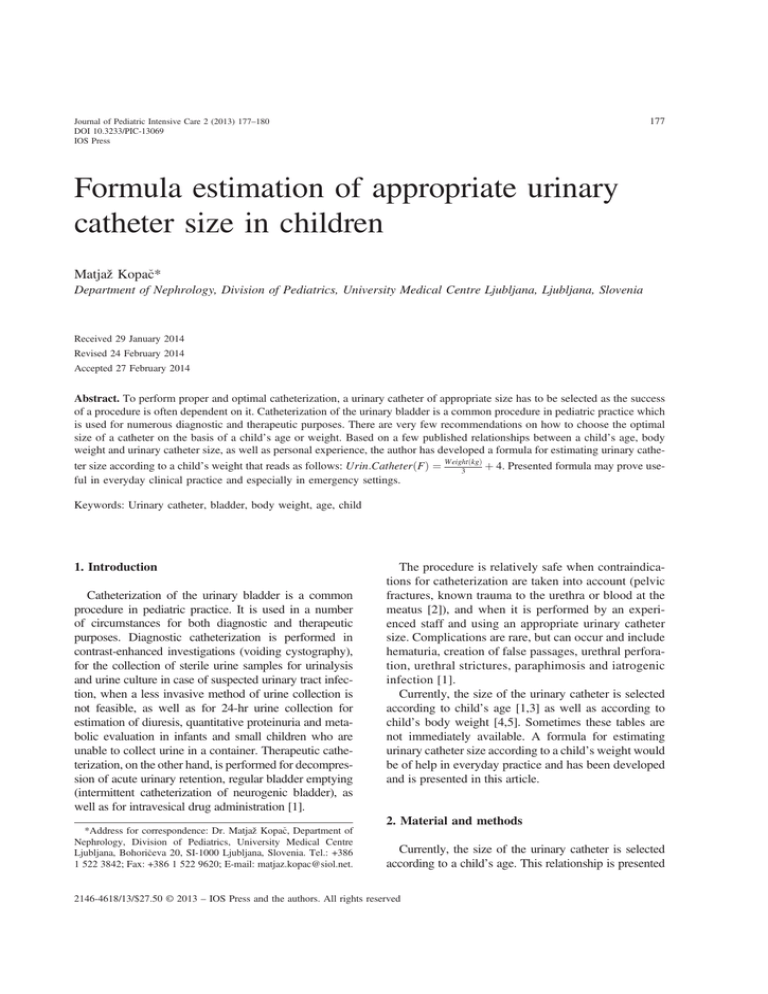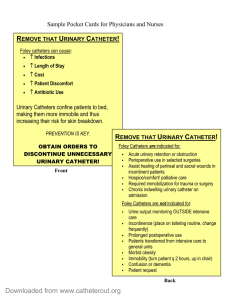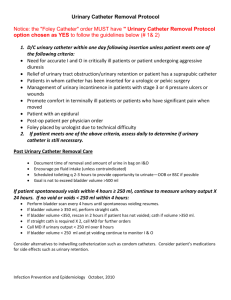
177
Journal of Pediatric Intensive Care 2 (2013) 177–180
DOI 10.3233/PIC-13069
IOS Press
Formula estimation of appropriate urinary
catheter size in children
Matjaž Kopac*
Department of Nephrology, Division of Pediatrics, University Medical Centre Ljubljana, Ljubljana, Slovenia
Received 29 January 2014
Revised 24 February 2014
Accepted 27 February 2014
Abstract. To perform proper and optimal catheterization, a urinary catheter of appropriate size has to be selected as the success
of a procedure is often dependent on it. Catheterization of the urinary bladder is a common procedure in pediatric practice which
is used for numerous diagnostic and therapeutic purposes. There are very few recommendations on how to choose the optimal
size of a catheter on the basis of a child’s age or weight. Based on a few published relationships between a child’s age, body
weight and urinary catheter size, as well as personal experience, the author has developed a formula for estimating urinary catheter size according to a child’s weight that reads as follows: Urin:CatheterðFÞ ¼ WeightðkgÞ
þ 4. Presented formula may prove use3
ful in everyday clinical practice and especially in emergency settings.
Keywords: Urinary catheter, bladder, body weight, age, child
1. Introduction
Catheterization of the urinary bladder is a common
procedure in pediatric practice. It is used in a number
of circumstances for both diagnostic and therapeutic
purposes. Diagnostic catheterization is performed in
contrast-enhanced investigations (voiding cystography),
for the collection of sterile urine samples for urinalysis
and urine culture in case of suspected urinary tract infection, when a less invasive method of urine collection is
not feasible, as well as for 24-hr urine collection for
estimation of diuresis, quantitative proteinuria and metabolic evaluation in infants and small children who are
unable to collect urine in a container. Therapeutic catheterization, on the other hand, is performed for decompression of acute urinary retention, regular bladder emptying
(intermittent catheterization of neurogenic bladder), as
well as for intravesical drug administration [1].
*Address for correspondence: Dr. Matjaž Kopac, Department of
Nephrology, Division of Pediatrics, University Medical Centre
Ljubljana, Bohoriceva 20, SI-1000 Ljubljana, Slovenia. Tel.: +386
1 522 3842; Fax: +386 1 522 9620; E-mail: matjaz.kopac@siol.net.
The procedure is relatively safe when contraindications for catheterization are taken into account (pelvic
fractures, known trauma to the urethra or blood at the
meatus [2]), and when it is performed by an experienced staff and using an appropriate urinary catheter
size. Complications are rare, but can occur and include
hematuria, creation of false passages, urethral perforation, urethral strictures, paraphimosis and iatrogenic
infection [1].
Currently, the size of the urinary catheter is selected
according to child’s age [1,3] as well as according to
child’s body weight [4,5]. Sometimes these tables are
not immediately available. A formula for estimating
urinary catheter size according to a child’s weight would
be of help in everyday practice and has been developed
and is presented in this article.
2. Material and methods
Currently, the size of the urinary catheter is selected
according to a child’s age. This relationship is presented
2146-4618/13/$27.50 © 2013 – IOS Press and the authors. All rights reserved
178
M. Kopac / Formula for urinary catheter size
Table 1
Urinary catheter size according to a child’s age group [1]
Child’s age group
Newborns
Infants
Prebupertal Children
Adolescent
4–6
6–8
10–12
14
Urinary catheter size (F)
F – French (international unit for urinary catheter size).
Table 2
Urinary catheter size according to a child’s age group [3]
Age
U. catheter size (F)
Praemature
baby
Newborn
baby
3 months–4 years
6 years
8 years
>12 years,
adolescent
5
6
8
10
12
14
F – French (international unit for urinary catheter size).
Table 3
Urinary catheter size according to a child’s body weight [4,5]
Body weight
Urinary catheter size (F)
Newborn/small
infant 3–5 kg
Infant
6–9 kg
5–8
5–8
Toddler Small child
10–11 kg 12–14 kg
8–10
Child
15–18 kg
Child
19–22 kg
Large child
24–30 kg
Adult >32 kg
10–12
10–12
12
12
10
F – French (international unit for urinary catheter size).
in Table 1 [1] and Table 2 [3]. On the other hand, a table is
available that estimates child’s urinary catheter size
according to body weight [4,5] and is presented in
Table 3.
A formula exists for estimating a child’s body weight
according to age: Body weight (kg) = 2 × (age [yr] + 4)
[6]. This formula applies to children between 1 and
10 yr of age, and is a very useful tool especially in emergency situations, since it allows estimation of a child’s
weight before his/her arrival at the hospital. In this way
the appropriate equipment, including the urinary catheter,
as well as drugs and fluids, which are mostly given
according to a child’s weight, can be prepared in advance.
With the aim of estimating urinary catheter size
according to body weight, the estimated calculated body
weight was interpolated using the above-mentioned
formula, and the results are presented in Figure 1.
Subsequently, a formula for estimating urinary
catheter size according to child’s body weight was
developed, taking into account the relationship
between urinary catheter size and body weight presented in Figure 1. First a preliminary general formula was developed to describe the relationship
between urinary catheter size and body weight. As
can be seen from Figure 1 this relationship is linear
therefore the proposed preliminary formula could
BodyWeightðkgÞ
þ n, where k
be: UrinaryCatheterðFÞ ¼
k
is a regression coefficient (representing in fact the
slope of the curve in the diagram) and n is a value
(representing a correction factor) that has to be added
to the equation. A value k can be obtained by dividing
a value on y-axis (Urinary catheter size – axis) by a
corresponding value on x-axis (Body weight – axis):
ΔðUrinaryCatheterÞ
12−8
4
¼ 12
¼ 13.
k ¼ ΔðBodyWeightÞ , for example: k ¼ 24−12
A value n can then be obtained by solving a simple
equation by inserting corresponding values:
BodyWeightðkgÞ
, for example:
n ¼ UrinaryCatheterðFÞ−
3
¼
10−6
¼
4.
n ¼ 10− 18
3
3. Results
With the aim of estimating urinary catheter size
according to body weight, the estimated calculated body
weight was interpolated using the above-mentioned
formula, and the results are presented in Figure 1.
Subsequently a formula for estimating urinary catheter size according to child’s body weight was developed, taking into account the relationship between
M. Kopac / Formula for urinary catheter size
179
16
Urinary catheter size (F)
14
12
10
8
6
4
2
0
3
6
9
12
15
18
Body weight (kg)
21
24
27
30
Fig. 1. Graphic presentation of relationship between urinary catheter size and child’s body weight.
urinary catheter size and body weight presented in
Figure 1. The proposed formula reads as follows:
UrinaryCatheterðFÞ ¼
BodyWeightðkgÞ
þ4
3
The results obtained using this formula for catheter
size (expressed in the international unit F - French)
should be rounded to the nearest available urinary
catheter size and used only for children weighing up
to 30 kg. Thereafter the urinary catheter sizes for
adults can be selected. For example, if a child’s body
weight is 12 kg, we choose urinary catheter no. 8
because 12
3 þ 4 ¼ 4 þ 4 ¼ 8.
4. Discussion
Choosing a urinary catheter of appropriate size is an
important first step in bladder catheterization, as the
success of the procedure could depend on it. When a
too small catheter is chosen, the urine may leak around
the catheter and the diuresis estimation can be underestimated. On the other hand, when a urinary catheter that
is too large is chosen, it may irritate or even hurt the
sensitive urethral mucosa. Currently, the size of the
urinary catheter is selected on the basis of tables, which
estimate the catheter size according to child’s age [1,3]
as well as according to child’s body weight [4,5]. The
formula for estimating urinary catheter size according
to child’s body weight presented in this article may
be of assistance, especially in emergency settings, especially for physicians that don’t regularly perform urinary catheterization and are therefore not familiar with
published tables showing relations between age or
weight of child and urinary catheter size. The presented
formula is based on published relations between urinary
catheter size and child’s age and body weight [1,3,4,5].
Body weight is one of the basic vital physiologic
parameters, which can be determined quickly, and
easily in every child who is admitted to hospital or in
an outpatient clinic. But if there is no time for weighing
the child properly, such as in emergency situations, the
formula for estimating child’s body weight according
to age mentioned in the Methods section can be used
[6]. In such situations it may be more convenient to
use the formula for estimating urinary catheter size
according to weight as well. A clear limitation of this
approach is that children of similar age may differ
significantly in body weight. The formula seems to
be applicable only in underweight to average-built
children, because in extremely obese children it can
overestimate the proper size of the urinary catheter.
In conclusion, the presented formula for estimating
urinary catheter size according to a child’s weight
might prove useful in everyday clinical practice and
especially in emergency settings, taking into account
the limitations for its use.
References
[1]
[2]
Lacroix LE, Vunda A, Bajwa NM, Galetto-Lacour A, Gervaix
A. Videos in clinical medicine. Catheterization of the urethra
in male children. N Engl J Med 2010;363(14):e19.
Shilkofski N, Procedures. Body fluid sampling. E. Urinary
bladder catheterization. In: Robertson J, Shilkofski N, editors.
The Harriet Lane Handbook. 17th ed. Philadelphia: Elsevier
Mosby, 2005. p. 94.
180
[3]
[4]
M. Kopac / Formula for urinary catheter size
Custer JW, Rau RE. Pediatric parameters and equipment.
In: Custer JW, Rau RE, editors. The Harriet lane Handbook.
18th ed. Philadelphia: Elsevier Mosby, 2009. inside title page.
Chapter 12. Pediatric trauma. In: Hazinski MF, editor. Manual
of pediatric critical care. 1st ed. St. Louis: Mosby-Year Book,
1999. p. 590.
[5]
[6]
Broselow Pediatric Resuscitation Tape (adapted from).
Lincolshire, IL: Armstrong Medical Industries; 2011. Product
No: AE-4800.
Biarent D, Bingham R, Rodriguez-Nuňez A, et al. European paediatric life support course manual. 2nd ed. Antwerp–Belgium:
European Resuscitation Council (ERC); 2003. p. 7–9.






